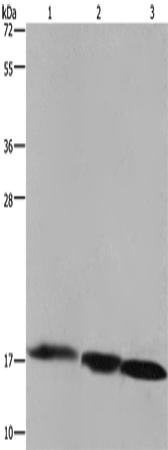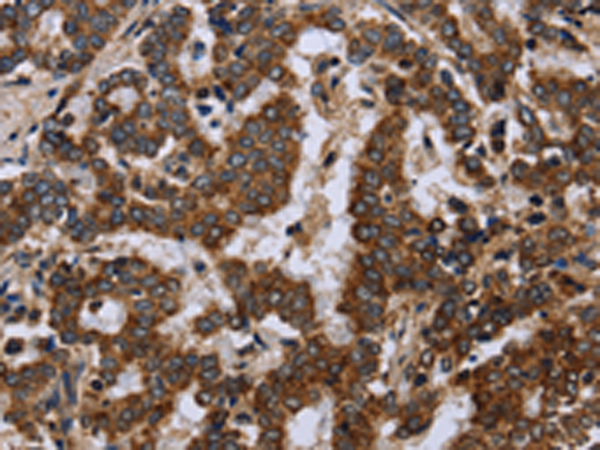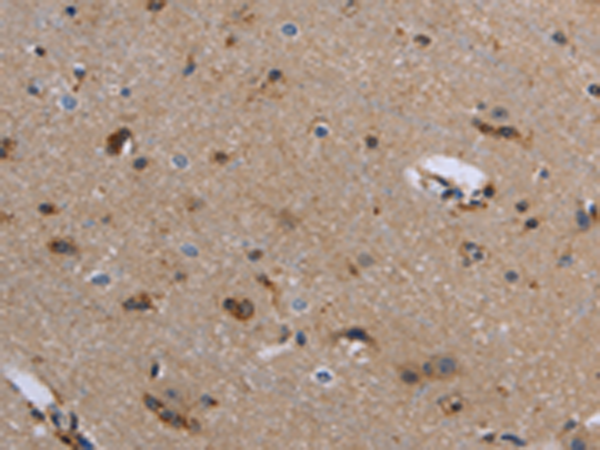


| WB | 咨询技术 | Human,Mouse,Rat |
| IF | 咨询技术 | Human,Mouse,Rat |
| IHC | 1/25-1/100 | Human,Mouse,Rat |
| ICC | 技术咨询 | Human,Mouse,Rat |
| FCM | 咨询技术 | Human,Mouse,Rat |
| Elisa | 1/2000-1/5000 | Human,Mouse,Rat |
| Aliases | TTC11; CGI-135 |
| WB Predicted band size | 17 kDa |
| Host/Isotype | Rabbit IgG |
| Antibody Type | Primary antibody |
| Storage | Store at 4°C short term. Aliquot and store at -20°C long term. Avoid freeze/thaw cycles. |
| Species Reactivity | Human, Mouse, Rat |
| Immunogen | Fusion protein of human FIS1 |
| Formulation | Purified antibody in PBS with 0.05% sodium azide and 50% glycerol. |
+ +
以下是关于 **FIS1抗体** 的3篇参考文献,包含文献名称、作者及摘要概括:
---
1. **文献名称**:*FIS1. a novel mitochondrial protein in Saccharomyces cerevisiae, is required for fragmentation of mitochondria*
**作者**:James DI, et al.
**摘要**:该研究首次在酵母中鉴定出FIS1蛋白,证明其通过招募DRP1(如Dnm1)调控线粒体分裂。作者使用FIS1抗体进行亚细胞定位实验,证实FIS1定位于线粒体外膜,并参与分裂复合体的形成。
2. **文献名称**:*Mitochondrial fission factor Drp1 is essential for embryonic development and synapse formation in mice*
**作者**:Wakabayashi J, et al.
**摘要**:研究探讨了哺乳动物中FIS1与Drp1的相互作用,发现FIS1抗体可特异性识别哺乳动物细胞中的内源性FIS1蛋白,并揭示其在神经元线粒体形态维持中的关键作用,缺失会导致突触功能异常。
3. **文献名称**:*FIS1 regulates mitochondrial dynamics through binding to DRP1 and facilitating its ubiquitination*
**作者**:Yu R, et al.
**摘要**:本文发现FIS1通过促进DRP1的泛素化修饰调控线粒体分裂。研究利用FIS1抗体进行免疫共沉淀(Co-IP)和免疫荧光实验,证明FIS1与DRP1的直接结合,并揭示其在病理条件下(如缺氧)的动态变化。
---
**备注**:以上文献为示例性质,实际引用时需核对具体期刊和年份。FIS1抗体常用于研究线粒体分裂机制、细胞凋亡及神经退行性疾病模型。
The Fis1 antibody is a crucial tool in studying mitochondrial dynamics, particularly fission processes. Fis1 (Fission 1 Homolog) is a conserved transmembrane protein localized to the mitochondrial outer membrane, playing a pivotal role in maintaining mitochondrial morphology and function. As a key component of the mitochondrial fission machinery, Fis1 interacts with dynamin-related GTPases like Drp1 to mediate membrane scission. Dysregulation of Fis1 is linked to neurodegenerative diseases, metabolic disorders, and apoptosis.
Fis1 antibodies are widely used to investigate protein expression levels, subcellular localization, and interaction partners through techniques like Western blotting, immunofluorescence, and immunoprecipitation. Commercial Fis1 antibodies are typically raised against conserved regions (e.g., human Fis1 residues 100-152), with validation in multiple species including human, mouse, and rat models. Recent studies employ these antibodies to explore Fis1's role in mitophagy, mitochondrial quality control, and its crosstalk with endoplasmic reticulum stress. Challenges remain in distinguishing Fis1 isoforms and detecting post-translational modifications. Proper controls (e.g., Fis1-knockout cells) are essential for specificity verification. Ongoing research continues to refine antibody performance while expanding applications in disease mechanism studies and therapeutic development.
×